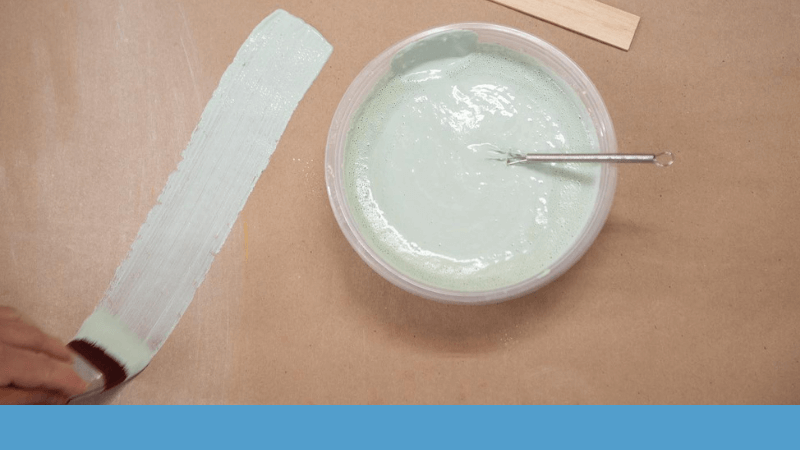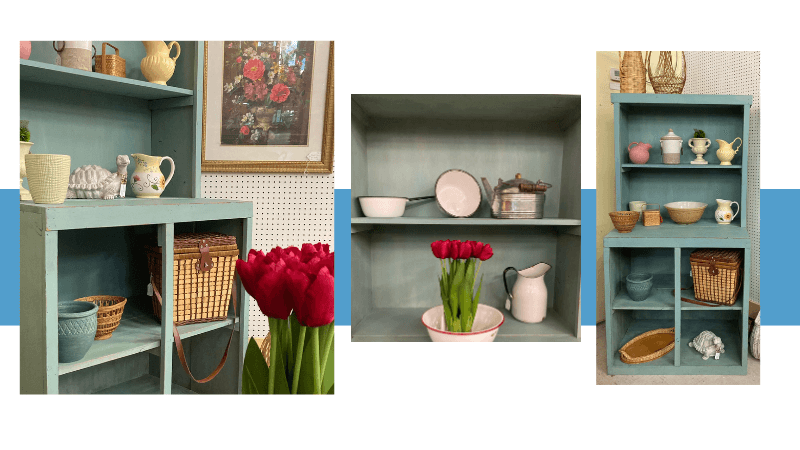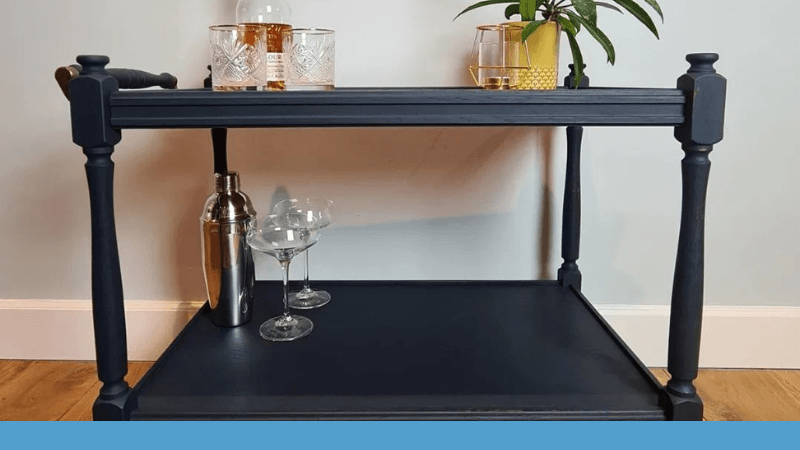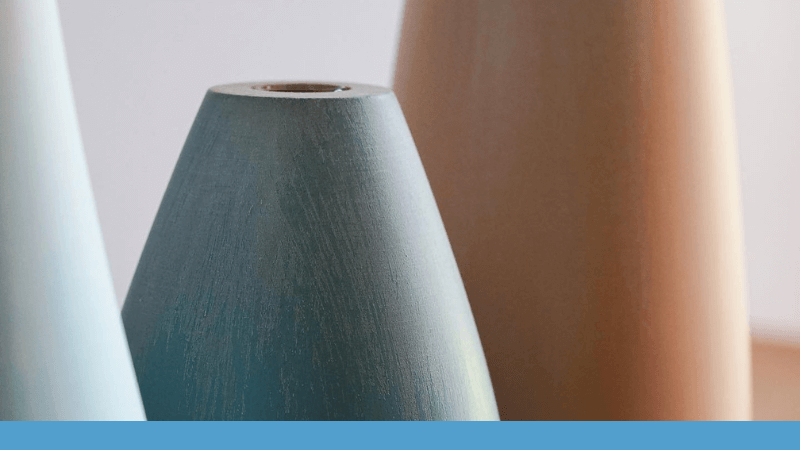In the early 1800s, commercially prepared paints were not widely available, and individuals had to rely on homemade paint recipes to finish their furniture. These formulas were passed down through generations, and one such paint known as milk paint gained popularity. Milk paint was created by combining milk, quicklime, and dry earth colors. Remarkably, milk paint has demonstrated remarkable durability, with numerous furniture pieces that are hundreds of years old still preserving the original paint intact. Today, milk paint continues to be utilized in special finishing techniques, showcasing its enduring appeal and unique qualities.
What is Milk Paint?
Milk paint gets its name from the utilization of casein, the principal protein in milk, as a chemical binder that adheres pigment to wood surfaces. Interestingly, casein had a prior history as a strong adhesive before its application as a pigment binder in milk paint. To obtain casein, the milk is skimmed using an acid such as vinegar, resulting in the formation of curds known as casein, which are also used in cheese making.

Since casein is insoluble in water, it is mixed with an alkali like quicklime, which creates a thin colloidal suspension. This mixture provides an ideal base for incorporating dry colors, resulting in the creation of paint. In the past, earth colors were predominantly available as pigments for milk paint. These earth pigments possess a subdued quality, contributing to the characteristic muted tones associated with milk paint.
Introducing Old Fashioned Milk Paint, a premium product that utilizes the same ingredients found in the original formulas. Unlike premixed milk paints, this authentic formulation offers superior and truly genuine colors. Not only is milk paint an environmentally friendly option for furniture finishing, but it also opens up a world of unique possibilities to achieve distinct aesthetic effects.
When it comes to color selection, milk paint provides a versatile range that is particularly well-suited for creating exquisite shaker furniture or achieving captivating distressed looks. Whether you're aiming for a subtle, timeless appearance or seeking to replicate a weathered and aged effect, milk paint offers the perfect palette to bring your vision to life.
But the artistic potential doesn't stop there. With milk paint, you can explore various techniques to add unique touches to your furniture. Create captivating crackle effects, where the paint dries with charming cracked lines, reminiscent of weathered surfaces. Embrace the art of intentional flaking, where patches of paint are carefully worn away, resulting in an authentic, lived-in appearance.
Brushing Milk Paint
Brushing is widely acknowledged as the primary and recommended technique for applying milk paint by hand. The water-borne composition of milk paint ensures a relatively fast drying time, enabling the application of multiple coats in a single day. This efficiency and convenience make it an attractive option for furniture finishing projects. While it is possible to create homemade milk paint, modern versions are readily available in the market. These commercial milk paints are offered in two main forms: premixed, akin to latex paint, or as a dry powder. Personally, I lean towards the dry powder form for its ability to impart a more authentic and traditional appearance to the finished result.
What you will need
Before diving into your milk paint project, proper preparation is essential. Here’s what you’ll need and a few important tips to ensure a successful painting experience.
First and foremost, gather your milk paint. Ensure you have enough for your project, as well as any additional colors you may require for desired effects or variations.
As milk paint contains lime, which can be caustic, it is crucial to prioritize safety. Wear gloves throughout the painting process to protect your skin. In the event of any contact with the paint, promptly wash it off to prevent any adverse reactions.
When it comes to choosing brushes for milk paint, synthetic bristle brushes are highly recommended due to the water-based nature of the paint. Synthetic bristles provide better control and maneuverability, especially when working with wet paint. Natural bristles tend to be too firm and may hinder the smooth application.
How to prepare a surface for milk painting
Start by ensuring that the surface you plan to paint is clean, dry, and free of any debris. If there are any rough areas or imperfections, sand the surface using at least 120-grit sandpaper. This will help create a smooth and uniform base for the milk paint application.
For adding character and enhancing the overall aesthetic, consider using edge tools like hand planes or scrapers. These tools can create subtle textures and accents that will show through the thin layers of milk paint, adding a touch of uniqueness to your finished piece.
Unlike other paints, milk paint does not require a separate primer or sealer. However, it does require a process called “dewhiskering” to ensure optimal adhesion. For previously painted wood surfaces, clean them thoroughly with mineral spirits and steel wool to remove any dirt, grime, or previous finishes. Once cleaned, lightly scuff sand the surface using 120-grit sandpaper to create a slightly roughened texture for better paint adhesion.
Applying Milk paint

To apply milk paint there are two ways you could go about it. You can either mix 1 part powder to 1 part water this easily covers the wood and obscures it with 1 or 2 coats. The other option is to add two parts water to one part powder to create a stain or wash that does not obscure the wood.
- Thin the paint mixture from Old Fashioned Milk Paint Company until it’s as thin as cream.
- Stir the paint continuously while painting to prevent pigment from settling at the bottom of the can.
- Don’t worry if you notice splotching; the second coat will cover it well.
- Brush on the first coat evenly, slightly overlapping the strokes.
- Let the first coat dry, then sand it with 320-grit stearated sandpaper. This step generates a lot of chalky dust.
- Wipe off the dust with a damp rag.
- Apply the second coat just like the first coat and let it sit for 24 hours.
- You have two options for the finish:
a) Leave it as is, which will result in a dry and chalky finish.
b) Apply a clear top coat.
To enhance outdoor furniture finished with milk paint, apply a coat of spar alkyd varnish or polyurethane. Solvent-based clear finishes, in general, intensify the paint color more than water-based finishes do. Clear wax achieves a similar effect to a lesser extent. For a smooth surface and a matte appearance, gently rub the paint with 0000 steel wool. Additionally, a thin layer of clear paste wax will enhance the smoothness of the finish.
Maintaining the Longevity of Milk Paint

To ensure the longevity of your milk paint finish, it’s important to follow some maintenance tips. While milk paint is known for its durability, proper care will help keep your furniture looking its best for years to come.
Regular Cleaning:
Dust and dirt can accumulate on the surface of your milk-painted furniture over time. To clean it, use a soft, lint-free cloth or a feather duster to gently remove any debris. Avoid using abrasive cleaners or harsh chemicals, as they can damage the paint. If necessary, you can lightly dampen the cloth with water for more stubborn stains, but make sure to dry the surface thoroughly afterward.
Avoid Excessive Moisture:
Milk paint is water-based and can be sensitive to prolonged exposure to moisture. Avoid placing your milk-painted furniture in areas prone to high humidity or near water sources. If the furniture does get wet, promptly dry it with a clean cloth to prevent water damage.
Protection from Sunlight:
Like any paint, milk paint can be affected by prolonged exposure to direct sunlight. Over time, UV rays can cause the colors to fade or change. If possible, position your milk-painted furniture away from direct sunlight or use curtains or blinds to protect it during the sunniest parts of the day.
Addressing Scratches and Wear:
Despite its durability, milk paint can develop minor scratches or signs of wear over time, especially in high-traffic areas. To address these issues, you can touch up the paint using a small brush and matching milk paint color. Apply a thin layer to the affected area and let it dry. For deeper scratches or chips, you may need to sand the area lightly before applying the touch-up paint.
Reapplying Top Coats:
Over time, the protective top coats applied to milk paint may wear off or lose their effectiveness. It’s recommended to periodically evaluate the condition of the finish and reapply a fresh coat of spar alkyd varnish, polyurethane, or clear paste wax as needed. This will help maintain the beauty and protect the underlying milk paint layers.
Embracing the Unique Charm of Milk Paint
One of the fascinating aspects of milk paint is its ability to develop a natural, aged patina over time. As the paint ages, it can acquire a slightly weathered or crackled appearance, adding to the charm and character of the piece. This characteristic patina is often highly sought after, especially in rustic or antique-inspired furniture.
If you prefer to preserve the original look of the milk paint, avoid aggressive cleaning or refinishing techniques that may strip away the natural aging process. Embrace the gradual transformation and appreciate the unique personality that develops over time.
Experimentation and Creativity

Milk paint offers a wonderful opportunity for creativity and experimentation. While traditional milk paint colors are often earthy and subdued, modern versions offer a wide range of shades to suit various styles and preferences. Don’t be afraid to mix different colors together to create custom shades or try different application techniques for unique effects.
Additionally, milk paint can be used on various surfaces beyond furniture, such as walls, cabinets, and decorative accents. Let your imagination guide you and explore the possibilities of this versatile paint.
Conclusion
Milk paint has a rich history and enduring appeal due to its natural ingredients, durability, and unique aesthetic. Whether you’re refinishing a vintage piece or creating a new project, understanding the application process, and maintenance tips, and embracing the distinct characteristics of milk paint will help you achieve stunning results. With proper care and periodic maintenance, your milk-painted furniture will continue to be a cherished and beautiful addition to your outdoor space for years to come.
